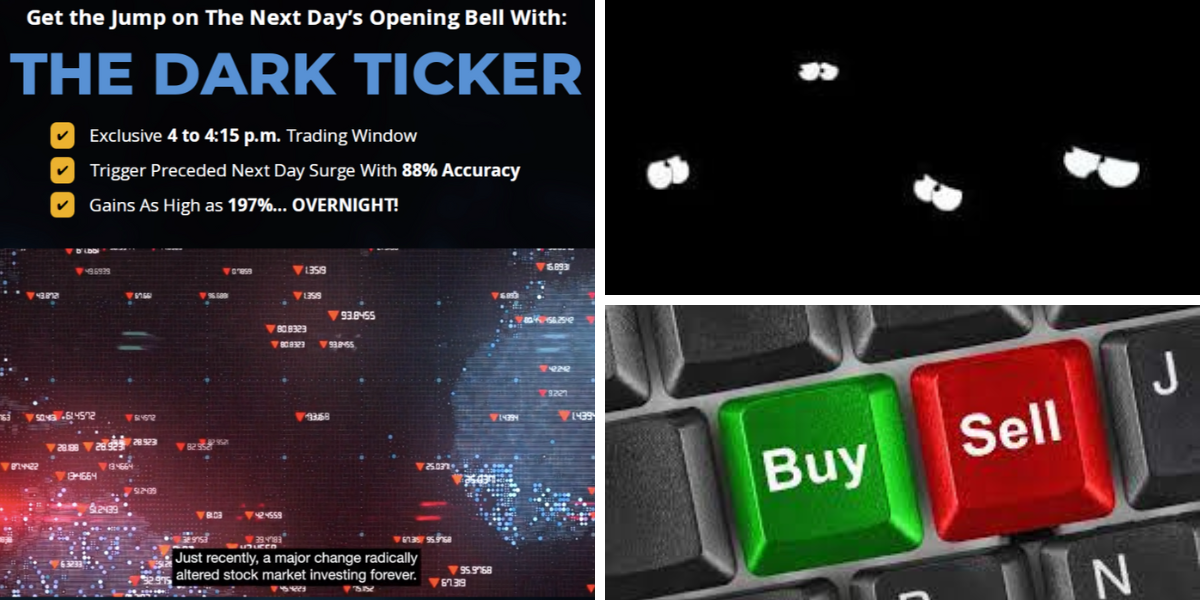According to former CBOE trader Bryan Bottarelli, a major change has radically altered stock market investing forever.
The change is a powerful new trading symbol called the “Dark Ticker” which can do something almost no other ticker symbol can do and it is now available to retail investors.
The Teaser
Bryan is teasing a special after-hours ticker symbol that can give us the single most powerful advantage in market history.

Bryan Bottarelli has some authority here, as he got his start trading in the fast-paced Apple trading pits during the dot-com boom (and bust) and now he’s a multimillionaire independent trader.
We have previously done an in-depth review of the Monument Trader's Alliance, where Bryan is the Head Trade Tactician, and we have also looked at similar pitches in the past, like Brian Christopher's Flow Trading System.
The reason this “Dark Ticker” is so highly touted is because it grants us the special privilege to trade in a 15-minute after-hours window from 4 pm to 4:15 pm.
This is when “the magic” happens.
Extended-Hours Trading
Both after-market and pre-market trading are when trading spreads are the widest, volatility is the highest, and the biggest price swings happen.
According to a study done by the Monument Trader's Alliance, which is not linked, they discovered that when “one simple trigger popped, the Dark Ticker rose the next day 88% of the time” or almost 9 out of every 10 times!
Furthermore, the day after a Dark Ticker trade was triggered, it showed the potential for wins of up to 197% in less than 24 hours.
Like in this trade example from March 22, 2023, which could have led to 145% overnight gains:

Based on the historical testing, it's essentially an “unfair advantage” that’s available in only one small corner of the market.
So what is this corner of the market that the Dark Ticker exploits for untold profits?
This is the strategy part we look at next, which Bryan says will give us multiple chances for triple-digit gains throughout the year.
The Pitch
This strategy is laid out for members of a brand-new service called Post-Market Profits.

The service is only available to charter members of the Monument Traders Alliance Inner Circle, which costs a cool $3,997 to join and gives you access to everything Monument has to offer, from near real-time Dark Ticker trade alerts to a post-market profits strategy guide, and every single newsletter by every “in-house expert” on the payroll.
How the Dark Ticker Strategy Works
It's a fairly straightforward three-step process that starts with days when the market closes down just 1%.
Step One: Wait for the Market to Fall by at least 1%
This is because more often than not when stocks are down big one day, they will move in the complete opposite direction the very next morning.
It's not just a hunch, but a mathematical fact.
Get this, when the market closes down just 1% on any given day, the odds of it rising the next day are over 88%.
This goes back a full decade:

Even more incredibly, over the last three decades, there have been 21 days when the market dropped 5% or more.
After every single one of those 21 days, the market ripped higher the next day.

This is where the Dark Ticker comes in.
Sure we could just buy the market dip, but by the time the markets open the next day, the big moves have already happened.
This is because while we were busy sleeping, Wall Street's automated bots were loading up on orders overnight like a professional cat burglar. The next day, they cash out, while we're just getting in and are left holding the bag.
However, by making a Dark Ticker trade, we can potentially profit on the 88% chance of a move up.
Step Two: Trade The Dark Ticker
We make such a trade by buying the after-hours version of any of the broad market exchange-traded funds.
This includes the QQQ for the Nasdaq, the DIA for the Dow, and Bryan's personal favorite, the S&P 500 index's ETF – SPY.
The SPY ETF has been around for a long time, but just recently it’s been granted an exclusive special trading window from 4 to 4:15 pm every day, giving us after-hours trading access.
This leads us back to March 22nd and step three.
Step Three: Close Out The Trade…targeting a win of 100% or more
When the S&P dropped 1.6% on March 22, 2023, all we would have had to do was make a special trade on the Dark Ticker, the after-hours SPY between 4 and 4:15.
Then, the very next day on March 23rd, we would have had a 145% gain that we could cash out.
All of this begs the question, what is the after-hours, “Dark Ticker” for ETFs like the SPY?
What Are Bryan Bottarelli’s “Dark Tickers”?
At this point in the presentation, Bryan finally fesses up.
The Dark Tickers for ETFs like the SPY are called “zero-day options.”
A zero-day option or 0DTE is simply an options contract set to expire at the end of the day it is purchased, making them ideal for the one-day trading strategy being employed here.
No other trades or tickers are promoted apart from 0DTE options on the SPY ETF.
We already know about the potential upside these trades have, but what about the downside and how easy is the strategy to execute? Let's get the inside scoop on Dark Ticker trades.
Legit 88% to 100% Success Rate?
The big claims made by Bryan in the pitch are:
- An 88%-100% trade success rate
- Backed by three decades of data
If we only trade after days when the market is down 1% or more as advised, which happens to be about 25 to 35 times annually or around twice per month, the advertised success rate should be ours.
However, the “backed by three decades of data” claim is where things begin to get murky.
Since daily zero-day options are a relatively recent phenomenon, Monument Trader's Alliance estimated how much such options would have moved if we traded them only on the days when the market was down at least 1%, going back as much as 30 years.
This is far different than actual back-testing and live market results.
Fortunately, there may be an easier way to play this strategy than getting mixed up in options trades that expose us to potentially unlimited losses, should our trades go south.
After all, the study conducted by Monument admits that the average next-day move for the market after a down day is 0.92%. With options, such a 1% move in the market translates to about an 80% gain or loss, in either direction.
A Zero-Day Options ETF
Last year, a thematic ETF issuer went to market with two ETFs that write and sell zero-day put options:
- Defiance Nasdaq Enhanced Option Income ETF (Nasdaq: QQQY)
- The Defiance S&P 500 Enhanced Option Income ETF (NYSE: JEPY)
By design, these were structured to have similar pay-offs to covered call ETFs, but thus far both are down since listing last September.
Similarly, other longer-term covered call ETFs, such as the WisdomTree PutWrite Strategy Fund (NYSE: PUTW) and the JPMorgan Equity Premium Income ETF (NYSE: JEPI) have both underperformed the market since listing years ago.
One former options trader who is now director of passive strategies research, North America at Morningstar said “Zero-day-to-expiry options are pretty much a casino.”
In conclusion, the newly listed Defiance ETFs don't exactly replicate the zero-day options trading strategy following days when the market is down 1% or more and the strategy itself hasn't had enough time to be backtested live in the market. Either way, I'm staying away for now.
Quick Recap & Conclusion
- Former CBOE trader Bryan Bottarelli says a powerful new trading symbol called the “Dark Ticker” can do something almost no other ticker symbol can do and it is now available to retail investors.
- Trading this “Dark Ticker” after days when the market closed down at least 1% has yielded a success rate of between 88%-100% going back 30 years, with the average winning trade bagging close to an 80% gain.
- Everything we need to know about the strategy is revealed to us if we become members of a brand-new service called Post-Market Profits. The cost to join is a cool $3,997.
- The big reveal is that the “Dark Ticker” is a zero-day option on the S&P 500 ETF SPY.
- As you likely already know, options are a risky proposition, subject to unlimited losses, and it turns out, zero-day options have only been around a short amount of time, so the success rate and average gain mentioned in the presentation are only estimates of what such options trades would have netted if they existed.
If you have or would try out the zero-day options trading strategy, let us know in the comments section.

